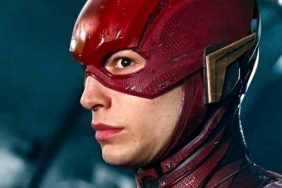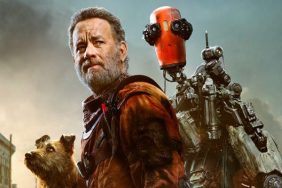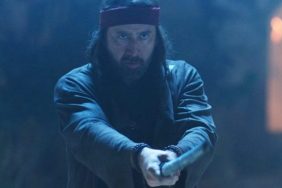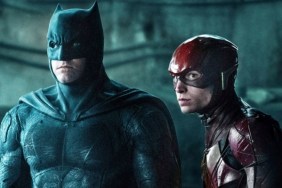
CraveOnline: I love that this is so important to you. I’ve talked to a lot of filmmakers who now love the ease of CGI and digital filmmaking, and that you don’t have to do it all for real. Why is it so important that you do it for real?
George Miller: It’s in the DNA of the films. This film, this doesn’t defy the laws of physics. There’s no flying humans or spacecraft. So when you can get a real car, in a real environment, impacting another real car, why do it digitally? It’s just the nature of the film. And we shot in continuity as much as possible, so it just made everything more authentic, the attrition on the characters and the vehicles, and that is evident in the film because we were out there in an isolated place with all the logistics of warfare and organizing people and whatever. The dust and the heat and all of that, even though it did get cold in the mornings and things. That seeps into the film.
“When you can get a real car, in a real environment, impacting another real car, why do it digitally?”
So if you were making Mad Max 2 today, you would be making it more or less the same, then?
Yeah, definitely.
Good! Because it’s awesome.
Yeah, definitely. Back then, simple things… There was no video split and the dailies took a week to come. Now I see them instantly. Big difference.
It’s amazing to think about what that production must have been like…
Back then?
It sounds like it must have been apocalyptic to even make The Road Warrior in some ways. You’re very isolated, you have to wait for the technology, for all your dailies to come in. It sounds like it was very seat of the pants a lot of the time. You said you were doing the storyboards at the last minute, for example.
Well, the first Mad Max, I’d never been on a film set. I’d done short films but never on a big set with makeup and everything like that and so on. It was very low budget and we ran out of money for editing and post-production, so I spent a year editing the film by myself in our kitchen, while Byron Kennedy did the sound. And then working as an emergency doctor on the weekends to earn money to keep going. I’d got my best friend, and friends of friends of friends of his, and Byron ditto, and I thought, “Oh my God, we made a film and it won’t cut together and we’re going to lose all their money.”
So I was confronted with my failures for a year, and every frame I kept on saying, “I should do this, I should do that, I wish I’d done that, why did I do this, this is the solution…” and we put Mad Max together. And so it was my total surprise that it resonated around the world.
After I made the film I was talking to Peter Weir, and I said, “I don’t think I’ll ever make another film,” after I made Mad Max 1. I said, “It was too hard. Everything I had in my head, everything was conspiring against being caught on film.” And he said, “But George, every film’s like that!”
“Peter [Weir] said, ‘You’ve got to go into a film as if you’re going on patrol in the jungles of Vietnam.'”
That’s not encouraging!
I saw it like walking a big dog. You want it to go one way and it’s dragging you off into another way. And Peter said, “You’ve got to go into a film as if you’re going on patrol in the jungles of Vietnam. You don’t know where the snipers and the land mines are. You’ve got keep everyone together and you’ve got to get your objective. So you’ve got to be light on your feet and adaptive and agile.”
And that’s probably self-evident, but I went into Road Warrior with that in mind, and I had a wonderful crew and I had much more knowledge having examined all the things that I thought I’d failed to do in the first movie. With that, no matter what happened on that film, it was a kind of gonzo energy that went into that film, and in a way by going to Africa [for Fury Road], now there are 900 crew, literally staging those chases across the desert and through mountain passes and things like that, captured that same spirit.
Did it get easier in Thunderdome?
Thunderdome, I had a very hard time on that because Byron Kennedy was killed in a helicopter accident just before and we were doing two mini-series, I was very… I had a lot on my plate. I asked my friend George Ogilvie, who was working on the mini-series, “Could you come and help me?” But I don’t remember the experience because I was doing it to just… You know, I was grieving.
That must have been really horrible. It’s impressive it came out so great. That movie is amazing.
Yeah, it was the one film where I just don’t remember a lot of the shooting. It’s weird.
That must be weird.
Yeah, I remember most days. But after a while as you keep going on the film, like Fury Road, when I see Charlize… the real Charlize is not Charlize. That’s the one I’ve been with for the 18 months of post-production. When I see Tom, that’s not Tom. That’s Tom up on the screen, that’s an imposter! [Laughs.] I don’t see them very often. Mostly I’m seeing them in character. And the story happens over three days so they’re the same wardrobe in the same thing on Fury Road. So it’s a weird feeling. So I remember most of what happened on that film but that’s… yeah, I don’t know why. It’s funny.
William Bibbiani is the editor of CraveOnline’s Film Channel and the host of The B-Movies Podcast and The Blue Movies Podcast. Follow him on Twitter at @WilliamBibbiani.







